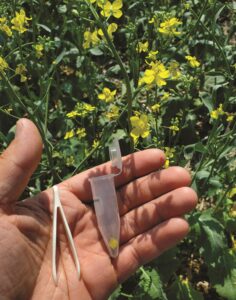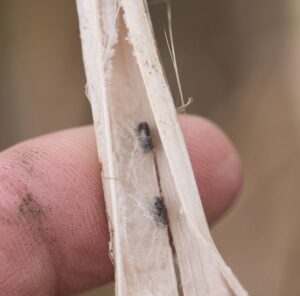New ways to assess sclerotinia risk
When late June-early July comes around, the thought on many minds is getting out to the lake or taking some much-needed rest now that the canola crop has finally cabbaged over and is filling in. However, one of the greatest yield robbers is getting ready to rear its ugly head, requiring us to get out into those fields with a sprayer and fungicide.
In some cases, the decision to spray or not spray is simple. The recent drought bias across much of the Prairies often reduced yield potential to the point where a fungicide isn’t economical. Easy no. On the other hand, when yield looks greater than 50 bu./ac. and the area has had some rain, fungicide will help you take as much crop as possible with you to the bin. Easy yes.
But what if the choice is less certain? Here’s a guide to help make that decision, and all the available tools, scouting practices and information you can use to make the correct choice.
The new Sclerotinia Risk Assessment Tool, when ready, will be available here.
The three elements of sclerotinia infection
A good plant pathologist always considers the disease triangle. Three components need to come together to have infection and subsequent yield loss: favourable environment, presence of the pathogen and a susceptible host.
Moisture
For sclerotinia stem rot in canola, the most important factor by far is the environment. Sclerotinia requires a wet and humid microclimate in the plant canopy for a prolonged period from germination of resting spores to infection of the leaves. When you walk through your crop and your pants get soaked, this is a good risk indicator. Agriculture and Agri-Food Canada research scientist Kelly Turkington completed a recent research project, funded through the Canadian Agricultural Partnership, that confirmed a more scientific approach: relative humidity of 80 per cent for at least 21 hours per day is required to have an elevated risk.
Other good indicators of moisture are precipitation (recent rains and what’s forecasted), soil moisture and leaf wetness. If you have a weather station on site, keep track of when you receive rain and how much, as prolonged rainfall over two weeks gives a higher risk than one thunderstorm. Note that weather stations may not accurately track how much rain landed a few miles away, especially in spotty thunderstorm conditions, so use this data as a guide rather than as a hard fact.

The pathogen itself
You can find one of the most recognizable steps in the sclerotinia life cycle, the sclerotia, in a post-harvest scout of canola stubble. These tiny raisin or mouse dropping-looking sclerotia initiate the cycle in future years, so accurate record keeping on fields with many sclerotia could indicate risk the next time you grow canola on that field.
Sclerotia produce the apothecia that, when they form under moist summer conditions, release the disease-causing ascospores. The small mushroom-like apothecia can be tough to find at times but are a great indicator that ascospores are likely being released through your crop canopy. These ascospores are microscopic, but technologies can help you measure the quantity of spores in the air. For example, Spornado (available through 20/20 Seed Labs) and a recent technology developed by Susie Li at Innotech Alberta, also funded through the Canadian Agricultural Partnership, can count spores in the air. If you suspect canola petals are infected with spores, another test option is the DNA-based testing kit from companies such as Quantum Genetix and Discovery Seed Labs.
Read the chapter on sclerotinia stem rot here.
Host-based factors
The last key to the puzzle is the interaction between the pathogen and the host. While almost all canola cultivars are susceptible in some capacity to sclerotinia, some have greater levels of resistance. Corteva cultivars P505MSL, P510G and B3014, available for 2024, have moderate levels of resistance which, when paired with a fungicide, can provide superior protection in very high-risk situations.
Canola plant density also has a role in the level of sclerotinia risk. A dense stand could produce a more favourable microclimate, and single-branching plants may be at more risk for lodging. Lastly, consider rotation; sclerotinia doesn’t just infect canola, but also other broadleaved plants like soybeans, potatoes and sunflowers. Gap years with non-susceptible plants or managing sclerotinia effectively each year will lower the risk of severe infection.
The updated risk assessment tool

Sclerotinia isn’t a simple pathogen, and many factors can influence the fungicide decision. To simplify the decision, the Canola Council of Canada (CCC) has created a new Sclerotinia Risk Assessment Tool expected to go live for the 2024 season. The tool includes factors such as precipitation, plant stand, crop rotation and scouting for apothecia to determine if a field meets the threshold for a fungicide application. The tool includes an economics calculator, where fungicide price, expected yield, crop price and suspected infection rate all provide an approximate rate of return on that fungicide application. Beta-testing based on current crop and input prices over the past two years suggests it pays to spray if a field has one in 10 plants infected.
The tool, when ready, will be added to the suite of tools at canolacalculator.ca.
Beyond the CCC’s Sclerotinia Risk Assessment Tool, several companies are developing their own models and tools based on similar factors and tested on canola grown across the Prairies. When deciding which tool to use, don’t forget to consider the timing of the assessment (predictions made a month or two ahead of spraying won’t be as reliable), and how it can be integrated into your farming operation.
Another option to consider is selective application of fungicides to high-risk areas within a field, such as low spots or areas with dense vegetation.
Making that spray decision doesn’t have to be difficult, and keeping these factors in mind will help you protect your yields and keep the money in your wallet as you kick back and relax at the lake.





